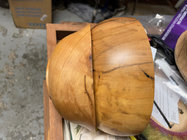After reading some advice here, I did a little test to prevent staining from iron dust left behind by tools. This is a picture of two bowls, both cut from the same maple tree, finished with Danish oil. The one on the left was wiped with lemon juice before applying the finish.
I have to believe that the gray splotches on the right bowl come from iron stains. The bigger, more defined black streaks are spalting or other grain colorations. Although the splotches don't ruin the appearance, it's interesting to see how much better it can be.

I have to believe that the gray splotches on the right bowl come from iron stains. The bigger, more defined black streaks are spalting or other grain colorations. Although the splotches don't ruin the appearance, it's interesting to see how much better it can be.

